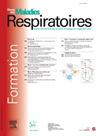Is the Cx43-specific inhibitor 43Gap26 a relevant therapeutic target in BPD and BPD-PH induced by hyperoxia?
IF 0.5
4区 医学
Q4 RESPIRATORY SYSTEM
引用次数: 0
Abstract
Introduction
Premature newborns exposed to oxygen are at risk for bronchopulmonary dysplasia (BPD), characterized by lung growth arrest and inflammation. Connexin 43-gap junction (Cx43-GJ) plays a central role in lung development and macrophages-induced inflammation, and is increased by hyperoxia. We thus explored the role of CX43-GJ in experimental BPD.
Methods
We used neonatal rats exposed to normoxia or hyperoxia (90% O2) and daily treated or not with a specific Cx43 inhibitor (43Gap26) during 14 days. Some experiments were also performed in human fetal pulmonary artery smooth muscle cells (HfPA-SMC) exposed to normoxia or hyperoxia (60% O2) and treated or not with 43Gap26 for 2 days.
Results
In vivo, we showed that 43Gap26 decreased hyperoxia-induced increased Cx43 expression in lung and improved hypo-alveolarization. However, 43Gap26 did not prevent 1) the hyperoxia-induced alteration of lung function (plethysmographie), 2) the decreased SP-B expression, 3) the disruption of extracellular matrix components (fibronectin and collagen I/III), 4) the increased macrophagic infiltration and M2 polarization, and 5) the increased secretion of pro-inflammatory cytokines (Tissue Inhibitor of Metalloproteinases-1). Furthermore, 43Gap26 blocked the hyperoxia-induced proliferation of type II alveolar epithelial cells, and did not prevent BPD-associated pulmonary hypertension (PH-BPD) or the increased mortality. In vitro, on HfPA-SMC, we confirmed that although an increased Cx43 expression was induced by hyperoxia, 43Gap26 had no effect on the hyperoxia-induced increase of pro-inflammatory cytokines such as IL-6 and Macrophage Inhibitory Factor (MIF). Finally, although we did not demonstrate an increase in oxidative stress in our 2 models, 43Gap26 decreased the hyperoxia-induced increase in heme oxygenase-1 expression in pulmonary arteries.
Conclusion
Despite an improved alveolarization in an animal model of hyperoxia-induced BPD, specific inhibition of Cx43 does not appear to be a new potential therapeutic strategy in BPD and PH-BPD as it did not prevent mortality as well as the main hallmarks of BPD and PH-BPD (altered lung function, pulmonary vascular growth arrest and remodeling, inflammation).
cx43特异性抑制剂43Gap26是高氧诱导的BPD和BPD- ph的相关治疗靶点吗?
早产儿暴露于氧气中有支气管肺发育不良(BPD)的风险,其特征是肺生长停止和炎症。连接蛋白43-间隙连接(Cx43-GJ)在肺发育和巨噬细胞诱导的炎症中起核心作用,并在高氧条件下增加。因此,我们探讨了CX43-GJ在实验性BPD中的作用。方法将新生大鼠暴露于常氧或高氧环境(90% O2),每天使用或不使用特异性Cx43抑制剂(43Gap26)治疗14天。将人胎儿肺动脉平滑肌细胞(HfPA-SMC)暴露于常氧或高氧(60% O2)条件下,43Gap26处理或不处理2天,进行了一些实验。结果在体内,我们发现43Gap26降低高氧诱导的肺组织Cx43表达增加,改善低肺泡化。然而,43Gap26并不能阻止1)高氧诱导的肺功能改变(体积图),2)SP-B表达降低,3)细胞外基质成分(纤维连接蛋白和胶原I/III)的破坏,4)巨噬细胞浸润和M2极化的增加,5)促炎细胞因子(金属蛋白酶组织抑制剂-1)的分泌增加。此外,43Gap26阻断了高氧诱导的II型肺泡上皮细胞的增殖,并没有阻止bpd相关性肺动脉高压(PH-BPD)或死亡率的增加。在体外,在HfPA-SMC上,我们证实了虽然高氧诱导Cx43表达增加,但43Gap26对高氧诱导的促炎细胞因子如IL-6和巨噬细胞抑制因子(MIF)的增加没有影响。最后,虽然我们在两个模型中没有证明氧化应激增加,但43Gap26降低了高氧诱导的肺动脉血红素氧化酶-1表达的增加。结论:尽管高氧诱导BPD动物模型的肺泡化得到改善,但特异性抑制Cx43似乎并不是BPD和PH-BPD的一种新的潜在治疗策略,因为它不能预防BPD和PH-BPD的主要特征(肺功能改变、肺血管生长停止和重塑、炎症)以及死亡率。
本文章由计算机程序翻译,如有差异,请以英文原文为准。
求助全文
约1分钟内获得全文
求助全文
来源期刊

Revue des maladies respiratoires
医学-呼吸系统
CiteScore
1.10
自引率
16.70%
发文量
168
审稿时长
4-8 weeks
期刊介绍:
La Revue des Maladies Respiratoires est l''organe officiel d''expression scientifique de la Société de Pneumologie de Langue Française (SPLF). Il s''agit d''un média professionnel francophone, à vocation internationale et accessible ici.
La Revue des Maladies Respiratoires est un outil de formation professionnelle post-universitaire pour l''ensemble de la communauté pneumologique francophone. Elle publie sur son site différentes variétés d''articles scientifiques concernant la Pneumologie :
- Editoriaux,
- Articles originaux,
- Revues générales,
- Articles de synthèses,
- Recommandations d''experts et textes de consensus,
- Séries thématiques,
- Cas cliniques,
- Articles « images et diagnostics »,
- Fiches techniques,
- Lettres à la rédaction.
 求助内容:
求助内容: 应助结果提醒方式:
应助结果提醒方式:


